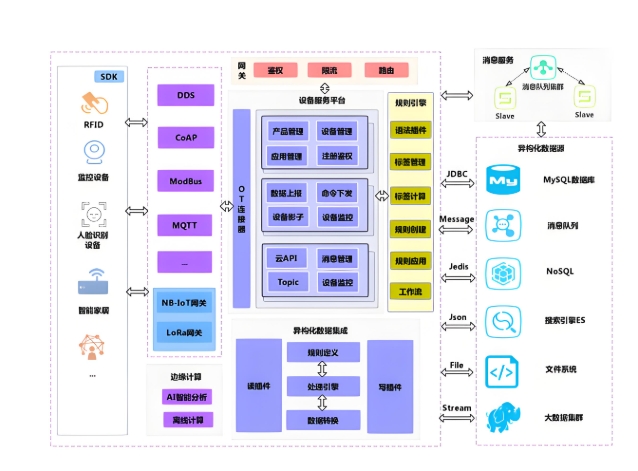Beginner's Guide to IoT Hardware Design: Building Smart Devices from Scratch
- latest articles
- 1.DApp Development & Customization: Merging Diverse Market Needs with User Experience 2.Analysis of the Core Technical System in DApp Project Development 3.How to achieve cross-chain interoperability in Web3 projects? 4.How does the tokenization of points reconstruct the e-commerce ecosystem? 5.How to Set and Track Data Metrics for a Points Mall? 6.What is DApp Development? Core Concepts and Technical Analysis 7.Inventory of commonly used Web3 development tools and usage tips 8.Development of a Distribution System Integrated with Social E-commerce 9.Six Key Steps for Businesses to Build a Points Mall System 10.What is DApp Development? A Comprehensive Guide from Concept to Implementation
- Popular Articles
- 1.Future Trends and Technology Predictions for APP Development in 2025 2.Analysis of the DeFi Ecosystem: How Developers Can Participate in Decentralized Finance Innovation 3.From Zero to One: How PI Mall Revolutionizes the Traditional E-commerce Model 4.DAPP Development | Best Practices for Professional Customization and Rapid Launch 5.Recommended by the Web3 developer community: the most noteworthy forums and resources 6.From Cloud Computing to Computing Power Leasing: Building a Flexible and Scalable Computing Resource Platform 7.How to Develop a Successful Douyin Mini Program: Technical Architecture and Best Practices 8.Shared Bike System APP: The Convenient Choice in the Era of Smart Travel 9.How to Create a Successful Dating App: From Needs Analysis to User Experience Design 10.From Design to Development: The Complete Process of Bringing an APP Idea to Life
With the rapid development of Internet of Things (IoT) technology, smart devices have become a part of our daily lives. Whether in home automation, health monitoring, environmental sensing, or industrial applications, IoT devices are continuously transforming how we live and work. However, designing and developing an efficient and reliable IoT hardware device is not a simple task, especially for beginners. Understanding each design step, the technologies involved, and best practices is crucial.
This article will guide you through detailed steps and suggestions to help you build an IoT hardware device from scratch. Whether you are a novice in IoT hardware design or an experienced engineer, this article will provide clear guidance, taking you step by step through the process of designing a successful smart device.
1. Basic Concepts of IoT Hardware Design
IoT hardware design covers a wide range of fields. It is not just about hardware design but also includes multiple aspects related to networking, sensors, communication protocols, power management, and more. Before starting the design, it is essential to understand the basic components of IoT hardware and the role of each part.
1.1 Basic Components of IoT Hardware
Sensors and Actuators: Sensors are the "senses" of IoT devices, responsible for collecting data from the external environment (such as temperature, humidity, pressure, etc.). Actuators are the "action" part, typically responding to data collected by sensors through motors, lights, or other control systems.
Microcontroller (MCU): The microcontroller is the "brain" of the IoT device, responsible for processing data received from sensors and making decisions based on preset algorithms. Common MCUs include Raspberry Pi, Arduino, ESP32, etc.
Communication Module: IoT devices need to communicate with other devices or cloud platforms, making the communication module an essential component. Common communication protocols include Wi-Fi, Bluetooth, ZigBee, LoRa, etc.
Power Management: IoT devices often need to operate for extended periods, so power management is critical. Common battery management solutions include lithium batteries, solar cells, etc. Additionally, effective power management design involves implementing low-power modes.
External Interfaces and Control: IoT devices need to interact with users or other devices, making external interfaces (such as touchscreens, buttons, LED displays, etc.) and control interfaces (such as USB, GPIO, etc.) indispensable.

1.2 IoT Hardware Design Process
The IoT hardware design process can generally be divided into the following steps:
Requirement Analysis and Function Definition: Clearly define the functions and goals the device needs to achieve, and determine the hardware components and performance requirements. For example, is it a smart home device or an industrial sensor?
Circuit Design and Prototype Building: Based on the requirement analysis, design the circuit schematic and create a PCB (Printed Circuit Board). Simultaneously, build a hardware prototype for initial testing.
Hardware Selection and Procurement: Choose suitable sensors, actuators, microcontrollers, and other components, and procure them. Factors such as performance, power consumption, and cost need to be considered.
Firmware Development and Debugging: After completing the hardware design, develop and debug the firmware (embedded software) to ensure the hardware and software work together seamlessly.
Testing and Optimization: After the hardware design is complete, conduct multiple rounds of testing to evaluate the device's performance, stability, power consumption, etc., and optimize based on the test results.
2. Steps to Build an IoT Hardware Device from Scratch
Next, we will explain in detail how to build an IoT hardware device from scratch, including specific operations and suggestions for each step.
2.1 Determine Application Scenarios and Functional Requirements
Before starting the design, first clarify the application scenarios and problems your IoT device will address. This determines which hardware components and communication protocols you need to use. For example:
Home Automation: If your goal is to design a smart home device, you may need temperature and humidity sensors, motion sensors, and Wi-Fi or ZigBee communication modules.
Health Monitoring: If you want to design a smart health device, you may need heart rate sensors, blood oxygen sensors, and choose Bluetooth as the communication protocol for easy connection with smartphones.
Industrial Monitoring: Industrial devices may require longer communication distances, so low-power wide-area network protocols like LoRa or NB-IoT might be a good choice.
After clarifying the application scenarios, you can create a detailed functional requirements document listing all the essential functions to be implemented.
2.2 Select Suitable Hardware Components
Based on the requirement analysis, selecting appropriate hardware components is crucial. Here are some suggestions for common components:
Microcontroller (MCU): When choosing an MCU, consider processing power, memory, interfaces, and power consumption. For example, the ESP32 is an excellent microcontroller for IoT projects, with built-in Wi-Fi and Bluetooth modules, making it suitable for applications requiring wireless communication.
Sensors: The choice of sensors depends on your application needs. For environmental monitoring, you might choose DHT22 (temperature and humidity sensor), MQ series (gas sensors), etc. For smart wearable devices, heart rate sensors, accelerometers, etc., may be suitable.
Communication Module: Choose the appropriate communication module based on the device's connectivity needs. If the device needs to connect to a Wi-Fi network, select ESP8266 or ESP32. For short-range communication, Bluetooth modules like HC-05 or BLE chips are good choices. For longer communication distances, LoRa or NB-IoT modules may be more suitable.
Power Management: Selecting the right battery and power module is very important. For low-power devices, lithium batteries or solar cells may be the best options.
2.3 Design the Circuit and Build a Prototype
Circuit design is a core part of IoT hardware development. You need to design the circuit schematic and create a PCB based on it. Common circuit design tools include Altium Designer, Eagle, etc. During the design process, factors such as power management, interface connections, and signal processing need to be considered.
After completing the circuit design, you can use development boards to build a prototype. Development boards like Arduino, Raspberry Pi, and ESP32 development boards can greatly simplify the development process, helping you quickly validate the circuit and functionality.

2.4 Develop Firmware and Debug
Once the hardware is built, the next step is firmware development. Firmware development is key to IoT hardware design, ensuring the hardware works as expected. You need to write code based on the hardware's functional requirements to control sensor data collection, actuator responses, and data exchange with cloud platforms or other devices via the communication module.
Common development environments include Arduino IDE, PlatformIO, etc., and the programming language is typically C/C++. Pay special attention to code optimization during development to ensure the device operates stably for long periods in low-power modes.
2.5 Testing and Optimization
The final step is testing and optimization. During development, you may encounter many issues, such as unstable circuits, inaccurate sensors, or excessive power consumption. Through testing, you can evaluate the performance of the circuit and software and optimize based on the results.
During testing, pay attention to evaluating the device's:
Battery Life: IoT devices often require long-term stable operation, so optimizing power management is crucial.
Communication Stability: Ensure the device's communication module works properly in various environments.
Hardware Stability: Test the circuit's stability to ensure there are no issues like overheating or short circuits.
3. Best Practices for IoT Hardware Design
To improve the efficiency and quality of IoT hardware design, here are some best practices:
Modular Design: Try to adopt a modular design to make the system easier to expand and maintain. Designing different functions (such as sensors, communication modules, power supplies, etc.) as independent modules can facilitate future upgrades and replacements.
Power Consumption Optimization: IoT devices often need to operate for long periods, so power consumption optimization is critical. Use low-power sensors and microcontrollers, and design power management solutions reasonably to minimize unnecessary power consumption.
Durability Design: IoT devices often need to operate under various environmental conditions, so consider the device's durability and stability. For example, choose suitable housing materials, waterproof designs, etc.
Data Security: Consider data encryption and communication security in the design to ensure secure data transmission between the device and the cloud platform, preventing information leaks and malicious attacks.
4. Conclusion
IoT hardware design is a complex but opportunity-rich field. From requirement analysis, hardware selection, prototype building, to firmware development and testing, each step is full of challenges. However, through continuous learning and practice, anyone can start from scratch and design a successful smart device.
Whether you are developing home automation products, health monitoring devices, or industrial sensor systems, you can master the essence of IoT hardware design step by step with the guidance in this article and move towards success.
-

How does artificial intelligence technology transform the operational models of modern enterprises?
In the wave of the digital era, artificial intelligence (AI) technology has tran···
-

How to Utilize Artificial Intelligence for Precision Medicine and Health Management
With the rapid advancement of technology, artificial intelligence (AI) has demon···
-

Integration and Application of Artificial Intelligence and Robotics
In today's era of rapid technological advancement, the integration of artificial···

 Blockchain
Blockchain










